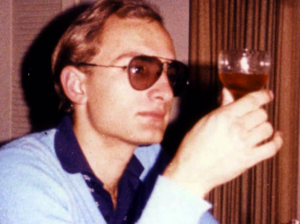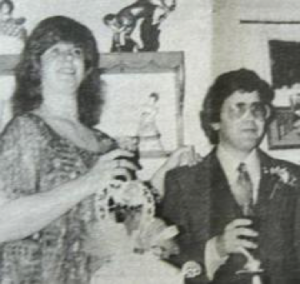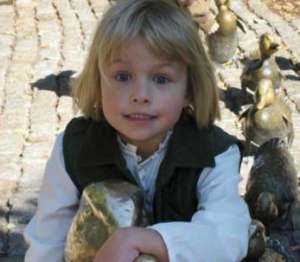The Thirteenth Baronet
From 1982 to 1985, Christopher Mountbatten Chichester rented a guest house from Ruth Sohus on Lorraine Road in San Marino. I lived only a couple blocks away and Chichester visited my neighbor across the street many times, but I can only recall meeting him once. He sat in the chair at the barber shop, getting his hair cut, while I waited my turn. He was in his twenties, short and slight, and he spoke with an aristocratic accent. I didn’t pay much attention to him because I didn’t realize what a big deal he was.
He was British, a descendant of Sir Frances Chichester, the first person to sail around the world alone, and he was a nephew of Lord Mountbatten, one of the Three Supreme Allied Commanders in
World War II. Chichester’s business card proclaimed his royal heritage: “Christopher Chichester, XIII Bt (13th baronet), San Marino, CA.” It sported his family crest, an egret with wings spread and an eel in its mouth, over the motto, “Firm en Foi” (firm in faith). He was a San Marino Rotarian and a member of the City Club; he hobnobbed with civic leaders; and he produced a television program on a public access channel entitled, “Inside San Marino.” He attended USC, working on his M.F.A. in Film Studies, and he was well-connected in the entertainment industry. He produced the movie, The Prisoner, and he secured passes for his friends to parties hosted by Stephen Spielberg and George Lucas.
While Chichester lived in Ruth Sohus’s guest house, her son, John, and his wife, Linda, moved into the main house with her and befriended Chichester. Suddenly in 1985, they left San Marino. Chichester told Ruth they had gone to France to work on a classified government project. About a month after they left town, one of Chichester’s relatives died, and he had to return to London to take care of the estate.
Months passed, and Ruth heard nothing from her son, so she filed a missing person’s report. The police couldn’t locate John or Linda. They wanted to talk to Chichester, but surprisingly they couldn’t find any record of anyone with that name and background. Strangely, fingerprints lifted from the guest house matched someone named Christian Gerhartsreiter, a German immigrant, but they couldn’t find this man either.
Time passed with no word about the missing persons. Ruth Sohus died in 1988 and her house was sold. That year someone named Christopher Crowe tried to sell a Toyota pickup in Connecticut. The buyer became suspicious because the name on the title was John Sohus. He called the police. They set up a sting, but Crowe didn’t show up.
 In 1994, nine years after Chichester left San Marino, my wife and I were driving down Lorraine Road on the way to our house when we came upon scores of police cars in front of the old Sohus house. A policeman stopped us. “What’s going on?” I asked. “Active crime scene. You’ll have to leave the area, sir.”
In 1994, nine years after Chichester left San Marino, my wife and I were driving down Lorraine Road on the way to our house when we came upon scores of police cars in front of the old Sohus house. A policeman stopped us. “What’s going on?” I asked. “Active crime scene. You’ll have to leave the area, sir.”
We were stunned. San Marino’s idea of a crime is parking your car on the street overnight in front of your own house. I’d never heard the words “active crime scene” used in the same sentence with “San Marino.”
The sordid details ripped through the rumor mill faster than we could get home. When the owners of the Sohus house started to dig a pool in the back yard, a backhoe unearthed three plastic bags filled with human bones. Forensic analysis revealed that someone bludgeoned a man’s skull with a blunt object, cut his body into three segments, and buried the parts in plastic bags. The police suspected the bones belonged to John Sohus, but they couldn’t establish a DNA match to a relative because he was adopted.
The case garnered national press coverage, culminating in an episode on the television program, Unsolved Mysteries, asking people to call in tips about the mysterious Gerhartsreiter. No one called.
The next year, in 1995, Clark Rockefeller married Sandra Boss in Boston. They were an impressive couple. He descended from the Percy Rockefeller branch of the family. A Yale graduate, he consulted with third world countries about debt financing. She was a graduate of Stanford and Harvard Business School and the youngest woman ever elected a director at McKinsey and Company. Clark’s money was tied up in family trusts and all his work was pro bono, so the couple lived on her seven figure salary.
Their daughter, Reigh (Clark called her Snooks), was born in 2001. Clark loved Snooks dearly, but marital strife threatened their special bond when Sandra filed for divorce in 2006. After a bitter battle, the court gave her custody of Snooks and restricted Clark to three eight-hour supervised visits per year. His friends say the separation ripped him apart. For two years he endured the restrictions, but in 2008 he snapped and kidnapped Snooks.
After a nationwide manhunt, the police found Clark in Baltimore, living as Chip Smith with his daughter, Muffy. In the run-up to Clark’s trial for kidnapping, the FBI matched his fingerprints to Gerhartsreiter, and San Marino residents identified the man splashed all over the national press as our Christopher Chichester.
The court in Boston sentenced him to five years for kidnapping and then flew him to LA to stand trial for Sohus’s murder. The case against him rested entirely on circumstantial evidence: traces of blood in the guest house; a University of Wisconsin logo on one of the bags containing the bones; a USC emblem on another bag; and Gerhartsreiter’s attempt to sell Sohus’s truck, using the alias Christopher Crowe. The jury found him guilty, and the judge gave him 27 years to life. Today, he sits in Ironwood State Prison in Blythe, California.
To date, no one has seen or heard from Linda Sohus, and the police have found no trace of her.
As with Anna Anderson, who claimed to be a Russian princess and was the subject of my blog post The Grand Duchess of Charlottesville, the truth about Gerhartsreiter is almost more astonishing than the fraud. He came from a backwoods village in the Bavarian Alps. His father was a house painter; his mother a seamstress. When he was seventeen, he lied on an application for a U.S. tourist visa, saying a family invited him to stay with them. He landed in Connecticut in 1978 and convinced a host family he was a high school foreign exchange student. They said he learned to speak flawless English with an aristocratic accent by watching episodes of Gilligan’s Island on television and mimicking the speech patterns of Thurston Howell III, the ascot-wearing millionaire. He never graduated from high school, but somehow gained admission to the University of Wisconsin, where he attended two quarters of college. On the verge of deportation in 1981, he married a woman he did not know in order to get a green card, and promptly left her for California. At the age of 20, he surfaced in San Marino as Christopher Chichester and showed up in film studies classes at USC. Faculty members and students assumed he was a student, but he never enrolled.
 Everything he said about himself in San Marino was a lie, and using that platform, he launched a three-decades-long career of stupendous frauds. He convinced titans of business and shrewd sophisticates that he was British royalty, a movie producer, a bond trader, a Rockefeller, and an expert in third world debt. And this only skims the surface. The biography, The Man in the Rockefeller Suit, by Mark Seal, is the definitive study. It’s a fascinating read, and I highly recommend it.
Everything he said about himself in San Marino was a lie, and using that platform, he launched a three-decades-long career of stupendous frauds. He convinced titans of business and shrewd sophisticates that he was British royalty, a movie producer, a bond trader, a Rockefeller, and an expert in third world debt. And this only skims the surface. The biography, The Man in the Rockefeller Suit, by Mark Seal, is the definitive study. It’s a fascinating read, and I highly recommend it.
During the Boston trial, psychiatric experts opined that Gerhartsreiter suffered from narcissistic personality disorder. It seems obvious they were right. He exploited everyone around him and loved no one.
Except for Snooks. His friends say he was completely devoted to her and she loved him, too. “I love you too much, Daddy,” they heard her say often.
Which brings us to the great irony of this story. An overwhelming love for someone other than himself brought down this relentlessly selfish con-man. He risked everything for Snooks, and as a result, all his frauds and crimes came out in the open. Everyone knows who he is, including Snooks, who is now fifteen. It seems unlikely that the little girl, who loved too much the man he was not, could possibly love at all the man he really is. All the punishment the justice system has meted out to him must be a mere inconvenience compared to that one irredeemable heartbreak.



November 22, 2021 @ 12:07 pm
As good as Mark Seal’s book is (and I would consider it the best reference about Gerhartsreiter’s life as a con), the most entertaining book about him is Blood Will Out by Walter Kirn, who wrote Up in the Air, and Blood Will Out provides a revealing and very funny account of his friendship with Rockefeller before he was outed as Gerhartsreiter. A must read about an aspect of human nature that many would not admit to: the need to feel important, or at the very least to accept the next best thing: to be in the good graces of somebody supposedly important
November 26, 2021 @ 8:09 am
Thanks for the reference. I’ll pick up Blood Will Out. Tapping into the need to feel important was definitely one of Gerhartsreiter’s great strengths as a con artist.
June 2, 2017 @ 1:47 pm
What an amazing story! Thank you for taking the time to share
June 2, 2017 @ 3:01 pm
Thanks, Karen!
March 26, 2017 @ 11:11 am
I am pretty sure there is a book in there (at least one)
January 22, 2017 @ 8:41 am
Makes you wonder about some of the unusual and mysterious birds you’ve met in your life. Well developed. Would love to learn more.
January 22, 2017 @ 12:35 pm
If you want to learn more about this strange duck, Pat, pick up a copy of The Man in the Rockefeller Suit. It chronicles all his spectacular frauds. I had to leave out a lot to keep this post to a reasonable length. For example, posing as Christopher Crowe, he ran a bond trading office for a major Wall Street firm, without ever having sold a bond in his life!
January 20, 2017 @ 2:10 pm
Excellent story well told!
January 20, 2017 @ 4:03 pm
Thanks, Don!